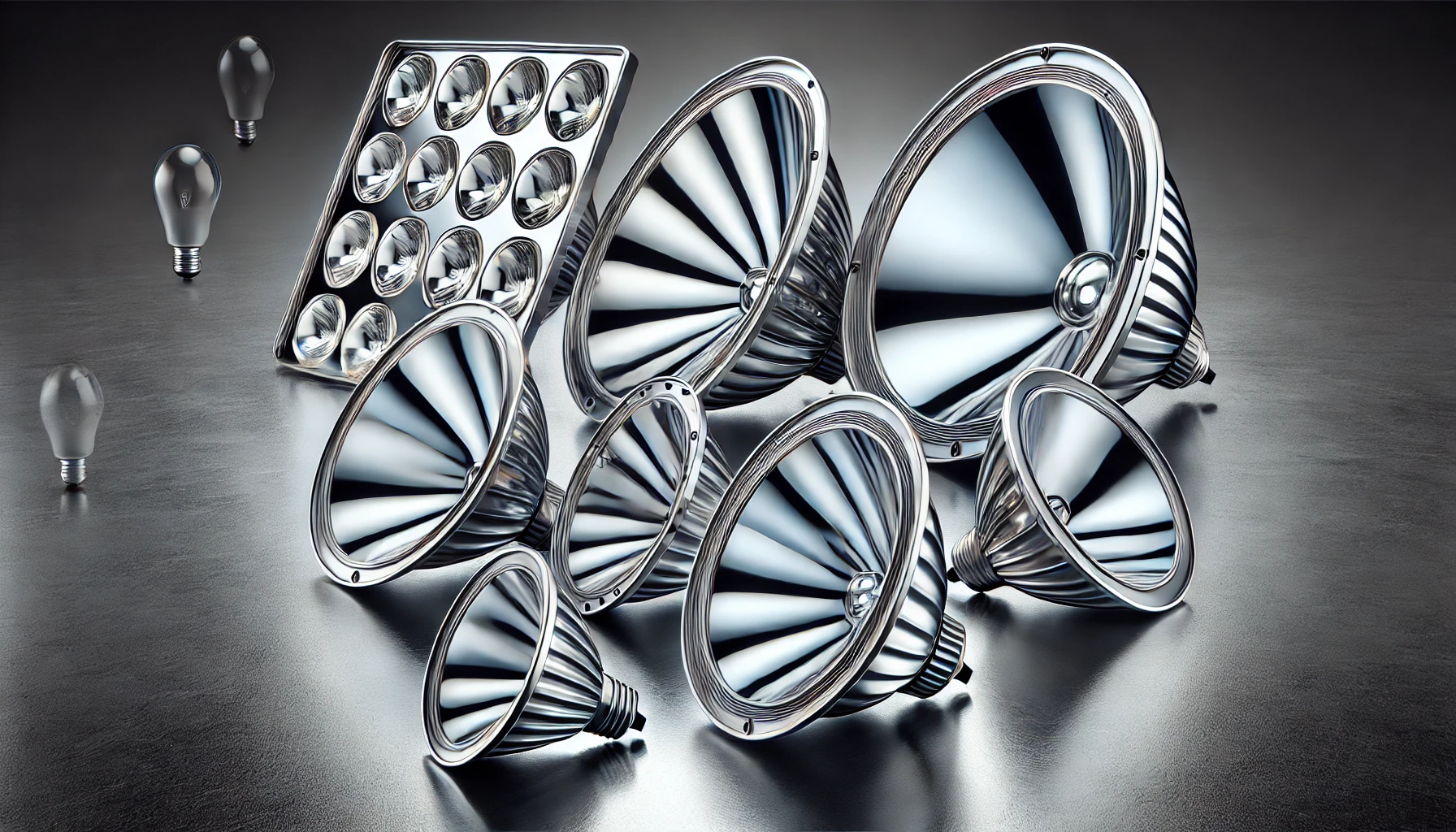
Introduction
Effective lighting is paramount in residential, commercial, and industrial spaces. Significantly, LED lighting technology has revolutionised the lighting industry. To further maximise the benefits of LEDs, the role of LED reflectors cannot be overlooked. These small yet powerful accessories help direct and enhance light, improving brightness and efficiency. This guide will take you through everything you need to know about LED reflectors—what they are, their importance, how they work, their uses, types, and how to choose the right one for your needs.
What are LED Reflectors? Definition and Purpose
LED reflectors are curved or shaped surfaces designed to redirect light from an LED source in a specific direction. These devices reflect the emitted light rays and prevent them from dispersing randomly. An LED reflector is made from aluminium, plastic coated with a reflective layer, or high-gloss materials like mirrored glass. The choice of material affects the reflector’s efficiency and the quality of light it redirects. Moreover, the fundamental purpose of these reflectors is to focus or redirect light and improve efficiency and brightness to achieve the desired lighting effect in desired areas.
Importance of Reflectors in LED Lighting
Reflectors are essential in LED systems to ensure the light is focused where needed. Without reflectors, light emitted from LEDs could scatter, leading to inefficiencies. Reflectors help create precise lighting patterns, brighter light output, reduced waste light, and improved overall performance. Additionally, properly designed reflectors can help minimise glare by controlling the angle at which light is emitted. This is essential for creating comfortable and visually pleasing lighting environments.
How Do LED Reflectors Work? Exploring Their Working Principle
LED reflectors function based on the light reflection principle. The inside of LED reflectors is typically coated with reflective materials that help capture the emitted light from the LED source and focus it where needed. When light strikes a reflective surface, it bounces back at a specific angle depending on the surface’s shape and texture. In the context of LED lighting, reflectors are designed to manipulate the direction and spread of light for optimal coverage.
LED Reflectors vs. Traditional Reflectors: A Brief Comparative Analysis
LED lighting reflectors outperform traditional ones by providing better efficiency, light control, and longevity. They are the go-to option for modern lighting solutions that typically last longer due to the durability of both the reflector materials and the LED lights themselves. Additionally, LED systems with reflectors consume significantly less energy compared to traditional lighting, reducing both operating costs and environmental impact.
Different Types of LED Reflectors Explained
LED lighting reflectors come in various types, each designed for specific lighting needs. Some popular variants include:
Parabolic Reflectors
Parabolic reflectors are designed to create highly focused light beams, often in flashlights or spotlights. In addition, the reflector’s shape ensures the light is concentrated into a sharp beam with minimal scattering, providing long-range illumination.
Elliptical Reflectors
These reflectors focus light more broadly than parabolic models. Elliptical reflectors are commonly used in applications requiring a wide beam of light, such as floodlights.
Asymmetric Reflectors
Asymmetric reflectors are used in scenarios where light needs to be directed in one particular direction or spread unevenly across an area. They are used for wall-washing and architectural lighting.
Specular Reflectors
These reflectors feature a mirrored surface that provides a high degree of light reflection, creating a very focused and intense beam of light. However, they are often used in applications where precision lighting is necessary.
Diffuse Reflectors
Diffuse reflectors scatter light evenly, resulting in a soft, widespread illumination. This type of reflector is used in ambient lighting and situations where harsh lighting is undesirable.
Choosing the Right LED Reflector: Fundamental Parameters to Consider
When selecting an LED reflector, consider the following key parameters:
Beam Angle and Spread – The beam angle of an LED reflector defines how widely the light spreads. Narrow beam angles (e.g., 15°-30°) are ideal for spotlights and accent lighting, while wider angles (e.g., 60°-120°) are suitable for general area lighting.
Reflector Size and Shape – The size and shape of the reflector also impact light distribution. Larger reflectors spread light over a broader area, while smaller, more compact reflectors focus light more intensely.
Compatibility – Reflectors work with specific LED types and shapes. Therefore, ensure that the reflector is compatible with your LED light source to match the two for optimal performance.
Material – Choose a reflector made from materials that suit your environment. For instance, aluminium, a durable and heat-resistant material, is ideal for outdoor use. Plastic reflectors are lighter and more affordable for indoor applications.
Broad-Range Applications of LED Reflectors Across Different Spaces
LED reflectors are used in a broad spectrum of applications and environments, including:
Spotlighting – Stage and Retail Displays
Reflectors create focused beams in spotlights, which are used in stage lighting, architectural lighting, and retail displays.
Floodlighting – Parks and Sports
Floodlights equipped with elliptical or diffuse reflectors provide wide-area illumination, making them ideal for sports fields, parking lots, and outdoor spaces.
Downlights – Homes and Offices
LED reflectors are used in downlights to focus light downward in a concentrated beam, commonly seen in homes and offices.
Automotive Lighting
Automotive LED Reflectors are crucial for headlights, brake lights, and turn signals. Furthermore, they provide an intense, focused beam of light, enhancing safety by improving visibility on the road.
Security and Outdoor Lighting
Reflectors in security lights help focus bright beams to cover specific areas, enhancing visibility and safety.
Installation and Maintenance of LED Reflectors
Installing LED reflectors is a straightforward process, but proper alignment is crucial to ensuring optimal performance. When installing a reflector, begin by securing the LED light source. However, attach the reflector, ensuring it’s properly aligned with the light beam. Adjust as necessary to achieve the desired light direction.
For maintenance needs, keep the reflective surface clean and dust- or debris-free, as this can reduce reflectivity. Periodically check for wear and tear, especially if the reflector is exposed to harsh environments.
Bottom Lines
LED reflectors are significant in maximising the efficiency and effectiveness of LED lighting. Moreover, investing in a quality reflector in your desired areas can enhance efficiency, improve light quality, and create effective and sustainable lighting solutions. Whether you’re looking to illuminate a large warehouse, accent architectural features, or enhance the safety of your vehicle’s headlights, choosing the right LED reflector can make a significant difference.





















